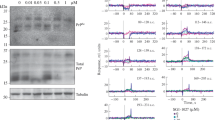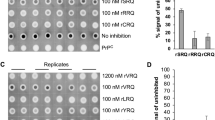Abstract
Biological effect of poly-L-arginine (PLR), the linear homopolymer comprised of L-arginine, was investigated to determine the activity of suppressing prions. PLR decreased the level of scrapie prion protein (PrPSc) in cultured cells permanently infected with prions in a concentration-dependent manner. The PrPSc inhibition efficacy of PLR was greater than that of another prion-suppressant poly-L-lysine (PLK) in a molecular mass-dependent fashion. The effective concentration of PLR to inhibit prions was achieved safely below the cytotoxic concentrations, and overall cytotoxicity of PLR was similar to that of PLK. PLR did not alter the cellular prion protein (PrPC) level and was unable to change the states of preformed recombinant PrP aggregates and PrPSc from prion-infected cells. These data eliminate the possibility that the action mechanism of PLR is through removal of PrPC and pre-existing PrPSc. However, PLR formed complexes with plasminogen that stimulates prion propagation via conversion of PrPC to the misfolded isoform, PrPSc. The plasminogen–PLR complex demonstrated the greater positive surface charge values than the similar complex with PLK, raising the possibility that PLR interferes with the role of cofactor for PrPSc generation better than PLK.






Similar content being viewed by others
References
Fitch CA, Platzer G, Okon M, Garcia MB, McIntosh LP (2015) Arginine: its pKa value revisited. Protein Sci 24:752–761
Oh D et al (2014) Enhanced cellular uptake of short polyarginine peptides through fatty acylation and cyclization. Mol Pharm 11:2845–2854
Emi N, Kidoaki S, Yoshikawa K, Saito H (1997) Gene transfer mediated by polyarginine requires a formation of big carrier-complex of DNA aggregate. Biochem Biophys Res Commun 13:231(2):421–424
Haider M, Ghandehari H (2003) Influence of poly(amino acid) composition on the complexation of plasmid dna and transfection efficiency. J Bioact Compat Polym 18:293–111
Takechi Y et al (2011) Physicochemical mechanism for the enhanced ability of lipid membrane penetration of polyarginine. Langmuir 27:7099–7107
Kibler KV et al (2004) Polyarginine inhibits gp160 processing by furin and suppresses productive human immunodeficiency virus type 1 infection. J Biol Chem 279(47):49055–49063
Ginsburg I, Borinski R, Malamud D, Struckmeier F, Klimetzek V (1985) Chemiluminescence and superoxide generation by leukocytes stimulated by polyelectrolyte-opsonized bacteria: Role of histones, polyarginine, polylysine, polyhistidine, cytochalasins, and inflammatory exudates as modulators of oxygen burst. Inflammation 9:245–271
Heckl S et al (2008) A novel polyarginine containing Smac peptide conjugate that mediates cell death in tumor and healthy cells. Med Chem 4:348–354
Rizk SL, Mold C, Haklin M, Roseman DL (1986) The role of C-reactive protein and polyarginine in tumor immunotherapy. Cancer 58:55–61
Yang Y, Wolfram J, Fang X, Shen H, Ferrari M (2014) Polyarginine induces an antitumor immune response through binding to toll-like receptor 4. Small 10:1250–1254
Prusiner SB (1997) Prion diseases and the BSE crisis. Science 278:245–251
Prusiner SB et al (1983) Scrapie prions aggregate to form amyloid-like birefringent rods. Cell 35:349–358
Ryou C (2011) Prion diseases. In: Harper D (ed) Encyclopedia of Life Sciences. Wiley, Chichester, pp 1–11
Lee J et al (2015) Laboratory diagnosis and surveillance of Creutzfeldt–Jakob disease. J Med Virol 87:175–186
Mays CE, Ryou C (2011) Plasminogen: A cellular protein cofactor for PrPSc propagation. Prion 5:22–27
Mays CE, Ryou C (2010) Plasminogen stimulates propagation of protease-resistant prion protein in vitro. FASEB J 24:5102–5112
Ryou C, Titlow WB, Mays CE, Bae Y, Kim S (2011) The suppression of prion propagation using poly-L-lysine by targeting plasminogen that stimulates prion protein conversion. Biomaterials 32:3141–3149
Jackson KS, Yeom J, Han Y, Bae Y, Ryou C (2013) Preference toward a polylysine enantiomer in inhibiting prions. Amino Acids 44:993–1000
Wernersson E et al (2010) Effect of association with sulfate on the electrophoretic mobility of polyarginine and polylysine. J Phys Chem B 114:11934–11941
Zama M, Ichimura S (1971) Difference between polylysine and polyarginine in changing DNA structure upon complex formation. Biochem Biophys Res Commun 44:936–942
Kang HE et al (2012) Characterization of conformation-dependent prion protein epitopes. J Biol Chem 287:37219–37232
Kim DH, Lee HM, Ryou C (2014) Evaluation of infective property of recombinant prion protein amyloids in cultured cells overexpressing cellular prion protein. J Korean Med Sci 29:1604–1609
Scott MR et al (1988) Prion protein gene expression in cultured cells. Protein Eng 2:69–76
Birkett CR et al (2011) Scrapie strains maintain biological phenotypes on propagation in a cell line in culture. EMBO J 20:3351–3358
Bian J et al (2010) Cell-based quantification of chronic wasting disease prions. J Virol 84:8322–8326
Kim SG, Lee HM, Ryou C (2014) Parameters that affect macromolecular self-assembly of prion protein. Protein J 33:243–252
Lim YB, Mays CE, Kim Y, Titlow WB, Ryou C (2010) The inhibition of prions through blocking prion conversion by permanently charged branched polyamines of low cytotoxicity. Biomaterials 31:2025–2033
Wessel D, Flügge UI (1984) A method for the quantitative recovery of protein in dilute solution in the presence of detergents and lipids. Anal Biochem 138:141–143
Doorley GW, Payne CK (2011) Cellular binding of nanoparticles in the presence of serum proteins. Chem Commun 47:466–468
Supattapone S et al (2001) Branched polyamines cure prion-infected neuroblastoma cells. J Virol 75:3453–3346
McCarthy JM et al (2013) Influence of surface groups on poly(propylene imine) dendrimers antiprion activity. Biomacromolecules 14:27–37
Xu Z et al (2011) Mechanistic insights into cellular alteration of prion by poly-D-lysine: the role of H2H3 domain. FASEB J 25:3426–3435
Wong C et al (2001) Sulfated glycans and elevated temperature stimulate PrP(Sc)-dependent cell-free formation of protease-resistant prion protein. Embo J 20: 377–386.
Wang F et al (2007) Lipid interaction converts prion protein to a PrPSc-like proteinase K-resistant conformation under physiological conditions. Biochemistry 46:7045–7053
Deleault NR, Lucassen RW, Supattapone S (2003) RNA molecules stimulate prion protein conversion. Nature 425:717–720
Deleault NR et al (2012) Isolation of phosphatidylethanolamine as a solitary cofactor for prion formation in the absence of nucleic acids. Proc Natl Acad Sci USA 109:8546–8551
Acknowledgements
This research was supported by the grants of the Korea Health Technology R&D Project through the Korea Health Industry Development Institute (KHIDI) funded by the Ministry of Health and Welfare, Republic of Korea (HI16C1085, HI16C0965) and the National Research Foundation of Korea (2012R1A1A2043356).
Author information
Authors and Affiliations
Corresponding author
Electronic supplementary material
Below is the link to the electronic supplementary material.
Rights and permissions
About this article
Cite this article
Waqas, M., Lee, HM., Kim, J. et al. Effect of poly-L-arginine in inhibiting scrapie prion protein of cultured cells. Mol Cell Biochem 428, 57–66 (2017). https://doi.org/10.1007/s11010-016-2916-6
Received:
Accepted:
Published:
Issue Date:
DOI: https://doi.org/10.1007/s11010-016-2916-6




